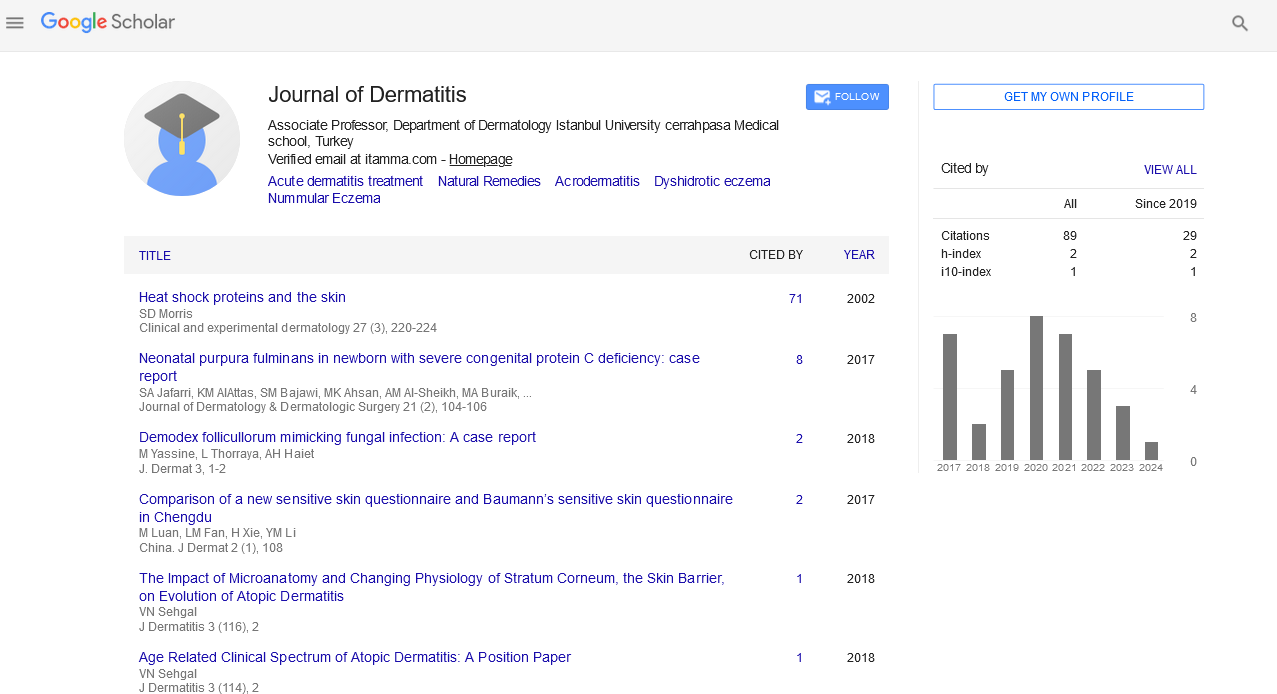Indexed In
- RefSeek
- Hamdard University
- EBSCO A-Z
- Euro Pub
- Google Scholar
Useful Links
Share This Page
Journal Flyer

Open Access Journals
- Agri and Aquaculture
- Biochemistry
- Bioinformatics & Systems Biology
- Business & Management
- Chemistry
- Clinical Sciences
- Engineering
- Food & Nutrition
- General Science
- Genetics & Molecular Biology
- Immunology & Microbiology
- Medical Sciences
- Neuroscience & Psychology
- Nursing & Health Care
- Pharmaceutical Sciences
Commentary - (2023) Volume 8, Issue 5
Emphasis on Exfoliative Dermatitis: The Epidemiology and Therapeutic Perspectives
Asghar Yoon*Received: 17-Aug-2023, Manuscript No. JOD-23-23481; Editor assigned: 21-Aug-2023, Pre QC No. JOD-23-23481 (PQ); Reviewed: 04-Sep-2023, QC No. JOD-23-23481; Revised: 11-Sep-2023, Manuscript No. JOD-23-23481 (R); Published: 19-Sep-2023, DOI: 10.35248/2684-1436.23.8.213
Description
Exfoliative dermatitis, also known as erythroderma, is a rare but severe skin condition characterized by widespread redness, scaling, and peeling of the skin. This condition affects individuals of all ages and backgrounds, making it pivotal to understand its epidemiology and therapeutic perspectives. Exfoliative dermatitis is a relatively rare condition, with an estimated annual incidence rate of 1 in 100,000 individuals. It affects both men and women, although some studies suggest a slightly higher prevalence in males. The condition can occur at any age, but it is most commonly diagnosed in adults between the ages of 40 and 60. Various underlying medical conditions have been associated with exfoliative dermatitis, making its epidemiology multifaceted.
Psoriasis
Psoriasis is a chronic skin condition that causes cells to build up rapidly on the skin's surface, leading to scaling and inflammation. Exfoliative dermatitis can be a severe complication of psoriasis.
Drug reactions
Exfoliative dermatitis is often triggered by adverse drug reactions. Medications such as anticonvulsants, antibiotics, and Non- Steroidal Anti-Inflammatory Drugs (NSAIDs) have been known to cause this condition in some individuals.
Lymphoma and leukemia
Exfoliative dermatitis can also be a sign of underlying hematological malignancies, such as lymphoma and leukemia.
Allergies and infections
Allergic reactions to certain foods, environmental allergens, or infections can lead to exfoliative dermatitis in some cases.
Therapeutic perspectives
The treatment of exfoliative dermatitis can be challenging, as it often depends on the underlying cause and the severity of the condition. Therapeutic approaches typically focus on relieving symptoms, addressing the underlying cause, and preventing complications. Here are some key therapeutic perspectives for managing exfoliative dermatitis:
Identification
It is essential to determine the root cause of exfoliative dermatitis. If the condition is drug-induced, discontinuing the offending medication is pivotal. For cases associated with underlying diseases like psoriasis or lymphoma, managing the primary condition is essential.
Symptomatic relief
Patients with exfoliative dermatitis often experience significant discomfort, including itching, pain, and inflammation. Topical corticosteroids and emollients can provide symptomatic relief by reducing inflammation and moisturizing the skin.
Hospitalization and supportive care
In severe cases of exfoliative dermatitis, hospitalization may be necessary. Patients may require intravenous fluids, antibiotics to prevent or treat infections, and nutritional support.
Immunosuppressive therapy
In cases where the condition is resistant to other treatments or associated with severe symptoms, immunosuppressive medications such as cyclosporine or methotrexate may be considered to suppress the immune system's response.
Phototherapy
Ultraviolet (UV) light therapy, such as narrowband UVB or PUVA (psoralen plus UVA), can be beneficial for some patients with exfoliative dermatitis, especially those with psoriasis-related erythroderma.
Conclusion
Exfoliative dermatitis is a rare but potentially severe skin condition with diverse underlying causes. Its epidemiology varies depending on the contributing factors, making it essential for healthcare professionals to approach each case individually. Treatment options focus on relieving symptoms, addressing the underlying cause, and providing supportive care. With proper management and early intervention, the prognosis for individuals with exfoliative dermatitis can be improved, offering hope for a better quality of life. Ongoing research and medical advancements continue to expand our understanding of this condition, for more effective therapeutic approaches in the future.
Citation: Yoon A (2023) Emphasis on Exfoliative Dermatitis: Epidemiology and Therapeutic Perspectives. J Dermatitis. 8:213.
Copyright: © 2023 Yoon A. This is an open-access article distributed under the terms of the Creative Commons Attribution License, which permits unrestricted use, distribution, and reproduction in any medium, provided the original author and source are credited.

